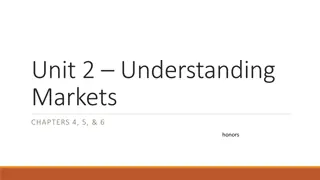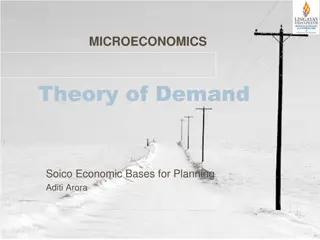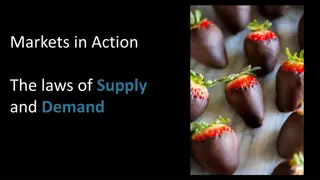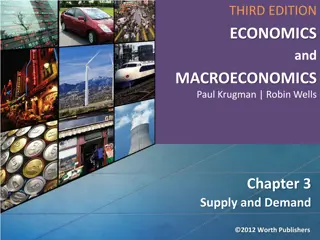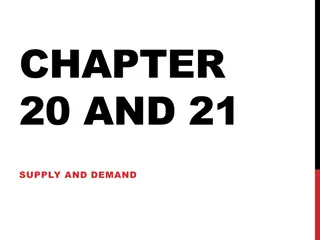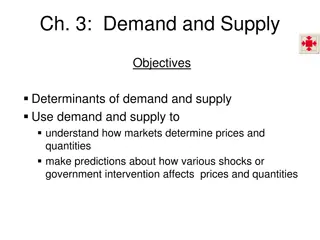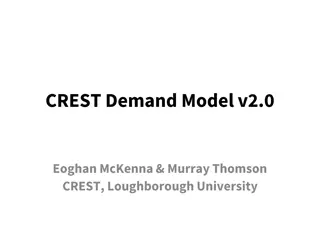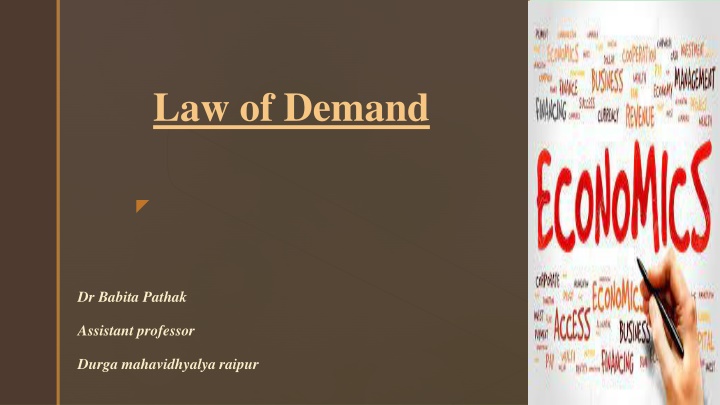
Law of Demand: Factors and Exceptions
Explore the Law of Demand with Dr. Babita Pathak, Assistant Professor at Durga Mahavidhyalya, Raipur. Learn about the demand function, inverse relationship between price and quantity demanded, assumptions, demand curve, and exceptions including Giffen paradox. Discover how price changes affect consumer behavior.
Download Presentation

Please find below an Image/Link to download the presentation.
The content on the website is provided AS IS for your information and personal use only. It may not be sold, licensed, or shared on other websites without obtaining consent from the author. If you encounter any issues during the download, it is possible that the publisher has removed the file from their server.
You are allowed to download the files provided on this website for personal or commercial use, subject to the condition that they are used lawfully. All files are the property of their respective owners.
The content on the website is provided AS IS for your information and personal use only. It may not be sold, licensed, or shared on other websites without obtaining consent from the author.
E N D
Presentation Transcript
Law of Demand Dr Babita Pathak Assistant professor Durga mahavidhyalya raipur
Law of Demand Demand Function Demand Function is a comprehensive formulation which specifies the factors that influence the demand for the product. Demand function states the relationship between the demand for a product and its determinants. 1. Individual Demand Function- ? = ? ? Where D= Demand, P= Price, F= Function 2. Market demand= ??= ?(?? ,??,?,?,?,?) Where, Dx = Quantity demanded for Commodity x ? = Functional relation ??=Price of commodity x ??=Price of commodity y which are substitutes or complemantary ? = Money income of consumer. ? = Taste and preference of a consumer ? = advertisement effect ? = Unknown variable
Law of Demand Law of Demand Explain inverse relationship between in quantity demanded and price of a commodity Higher the price, lower would be the quantity demanded Price and quantity demanded are negatively related This law is only qualitative statement not quantitative statement
Law of Demand According to the law of demand other things being equal, if the price of a commodity falls, the quantity demanded rise and if the price of commodity rises, its quantity demanded falls. Quantity demanded goes up When price goes up inverse relationship between quantity demanded and price Quantity demanded goes down When price goes Down
Assumptions of Law of Demand or Other thing being equal or Ceteris Paribus- 1. Price of related goods should not change. 2. Taste and preferences of consumer should not change 3. There should be no change in the income of the consumer. 4. There should be a rational behavior of a consumer 5. Distribution of income and wealth should be equal. 6. Government policies should not change 7. There should be no change in the size of the population.
Law of Demand 60 Price per Unit (Rs) Quantity Demanded (unit) 50 40 Price (Rs) 10 100 30 20 80 20 30 60 10 40 40 0 0 50 100 150 50 20 Quantity Demanded (Unit) Demand Schedule Demand Curve
Law of Demand Exception to Law of Demand 1. The goods of necessities- Demand unaffected even though their prices are increasing 2. Giffen paradox- The Giffen Paradox is named after Sir Robert Giffen. He observed that when the price of bread increased, then the low-paid British wage earners bought more of bread and not less. Since the wage earners diet was mainly bread, with the increase in price they were forced to cut down their consumption of meat and other expensive food items. Thus to maintain their food intake, they bought bread even at higher prices. This phenomena was referred to as Giffens Paradox . Demand for Giffen goods varies directly with price and thus is an exception to the law of Demand. 3. Commodities of prestige or status symbol- used by rich people for whom the price is not important factor.
Law of Demand 4. Expectation of future change in price- If price of a commodity increase and there is an expectation of further increase in its price, demand for such commodity will increase. 5. Ignorance of consumer- When consumer behave that higher price will have higher quality. 6. Emergency- Law of demand does not apply in case of war, famine, curfew




